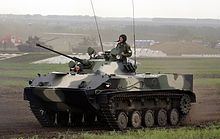Airborne tank

Airborne tanks are lightly armored, air-transportable armored vehicles that can be unloaded in unprepared places or placed on a parachute for use with airborne troops with an aircraft ( cargo gliders in World War II , later also helicopters or aircraft) in the area close to the front or in the enemy hinterland, often in unprepared places .
They are divided into the two main categories of self-propelled guns , which with their cannon armament as artillery or for direct fire support and as tank destroyers are mostly equipped with an anti-tank missile system, as well as armored personnel carriers for paratroopers. The armored personnel carriers or armored transporters are used for the various tasks of transporting riflemen, ambulance vehicles , radio and command vehicles ( command staff vehicles ), transporting supplies and fuels as well as transporting special equipment, e.g. for reconnaissance.
history
At the beginning of the 1930s, the military recognized the usefulness of parachute troops for operational missions near the front or in the deep rear of the enemy. While in other countries the deployment of parachute troops in smaller units for commando companies was planned, in the USSR it was assumed that even large units or groups should be able to be removed by parachute. It was also recognized that personal weapons (pistol, carbine) were not sufficient to carry out successful combat operations. At the same time, the mobility of the landing troops should be increased. Concepts for air transport and the dropping of heavy equipment such as machine guns, grenade launchers, cannons and ammunition, unarmored and above all armored vehicles for the airborne troops were developed in projects and tested in maneuvers in the early to mid-1930s. It was found that the use of the existing light armored vehicles was inexpedient due to the low transport capacity of the aircraft and that special airborne armored vehicles had to be developed. At that time, however, the industry in the USSR was unable to do this.

The first tank developed as an airborne tank was the American M22 Locust from 1943, which , like the Tetrarch , was not used on the British side until 1945 to a limited extent and with little success. The combat mission on D-Day , during which these were flown in by glider, was the first such tank mission in history.
After the Second World War, corresponding constructions were developed and prototypes were also tested in the USSR. In September 1951, the airborne SPG ASU-57 was added to the armament and went into series production. This was supplemented and replaced from 1958 by the ASU-85 and was used in the armament of the airborne divisions. Since the late 1960s, the Soviet airborne troops were equipped with the armored personnel carriers BMD-1 , BMD-2 , the armored transporter BTR-D and the airborne SPG 2S9 "Nona-S" . The BMD-3 and BMD-4 were added from the 1980s . It has been known since 2005 that a new generation of armored airborne vehicles will enter service within the next few years. It is a whole family of vehicles in which the chassis and main assemblies are modular and modified for special uses.
In the United States , the M551 airborne vehicle was introduced on a limited scale in the 1960s .
In recent years, airborne vehicles that are made in China and are part of the armament of the Chinese army have also become known.
The Waffträger Wiesel , developed in Germany in the 1980s, is an airborne, protected 'airborne weapon carrier ' on a tracked chassis, and replaces the Kraka as well as other light wheeled vehicles with limited off-road capability, with which various weapons equipment (20 mm automatic cannons , TOW anti-tank missiles , 120- mm mortars or anti-aircraft missiles Stinger ) can be transported and brought into battle.
In the People's Republic of China , the ZBD-03 airborne vehicle was introduced in the 1990s , which is conceptually comparable to the Soviet models of the BMD series.
Mission concept
The main disadvantage of airborne tanks is their light armor for reasons of weight, which severely limits their survivability compared to normal tanks and anti-tank systems as well as fire with infantry weapons. The relatively small armament of the first generations was also subject to the limited transport capacities. In order to enable the release and lowering capability despite the installation of large-caliber guns, closed superstructures were partly dispensed with.
The task of airborne tanks is not open combat with full battle tanks. Rather, they should increase the mobility of heavy weapons and increase the firepower of the paratroopers. The vehicles equipped with anti-tank guided weapons are, however, able to fight more heavily armored vehicles successfully from a cover or an ambush , even over long distances (up to 5 km).
The missions of the last 30 years have shown that airborne units with their special, armored vehicles are able to operate as autonomous and fully mobile units.

